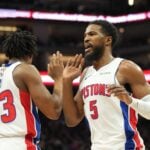
The Detroit Pistons made it a priority to stabilize the shooting guard position this offseason. President Trajan Langdon reshaped the shooting guard depth chart after a 2023–24 season with ten players at the spot . His goal was clear: bring consistency, veteran presence, and scoring to complement rising guard Jaden Ivey .
One of Langdon’s first moves was trading Quentin Grimes to the Mavericks for Tim Hardaway Jr. , a proven veteran and Dallas’ third-leading scorer. He followed that up by signing Malik Beasley to a one-year deal , adding another reliable perimeter threat with playoff experience. Langdon also acquired Wendell Moore Jr. in a low-risk trade to round out the group. The Pistons’ additions create a more stable, experienced shooting guard rotation, supporting Ivey and raising the team’s floor.
Grading the Pistons’ 2024-25 Shooting Guard Rotation and Impact
Jaden Ivey: Pistons’ Shooting Guard Shines Before Injury
This was a pivotal year for Jaden Ivey, who showed clear growth and an improved fit alongside Cade Cunningham . After starting last season on the bench behind Killian Hayes due to defensive concerns, Ivey found his rhythm and looked like a legitimate Most Improved Player candidate this season, raising his scoring average from 15.4 to 17.6 while improving his efficiency. He began carving out a role as the Pistons’ second scoring option, including two clutch game-winners.
His momentum was cut short by a broken fibula on January 1. The Pistons went 14–16 with Ivey and 30–22 without him, fueling debate about his long-term fit. Still, his leap in production and confidence gives Detroit reason for optimism heading into next season, where Ivey will look to prove his breakout was no fluke.
Grade: B
Tim Hardaway Jr.
Coming from a playoff-tested team in Dallas to a rebuilding situation in Detroit raised early questions about Tim Hardaway Jr.’s commitment, but those concerns quickly faded. He embraced a leadership role , holding teammates accountable and becoming one of the locker room’s most respected voices. Appearing in 77 games—second only to Jalen Duren —Hardaway started every contest and brought a steady, veteran presence to a young roster.
Though his scoring dipped from previous seasons, his efficiency saw a slight uptick. While he struggled in the postseason, his impact as a stabilizing force was clear. Hardaway’s future with the team is uncertain, with a crowded backcourt heading into the offseason. Still, his experience and professionalism remain valuable assets for a team trying to turn the corner.
Grade: B-
Malik Beasley
Malik Beasley may have been the Pistons’ best offseason acquisition. Signed to a one-year prove-it deal, he quickly became a key contributor and emotional spark, bringing production and confidence to a young roster. Beasley played in all 82 games and raised his average from 11.3 to 16.3 points per game. His 319 made three-pointers ranked second in the league, trailing only Anthony Edwards , and he finished as the runner-up for Sixth Man of the Year .
As defenses adjusted, Beasley was forced to expand his offensive game beyond spot-up shooting, which led to some inconsistency, especially in the playoffs, where he shot just 33% from three and 37% overall. Still, his value as a floor spacer is undeniable. Heading into the offseason, re-signing Beasley should be a top priority for Detroit’s front office.
Grade: A
Wendell Moore Jr.
Wendell Moore Jr. never had much of a chance to make an actual impact in Detroit. Acquired as part of a depth move, Moore appeared in just 20 games (one start), averaging 3.2 points per game in limited minutes. With a crowded backcourt and little opportunity to crack the rotation, he struggled to find a consistent role.
Ultimately, Moore was waived before the end of the season—his brief stint with the Pistons was more about roster flexibility than long-term plans.
Grade: D
Lindy Waters III & Alondes Williams
Lindy Waters III and Alondes Williams had brief stints with the Pistons, offering only small glimpses of their potential. Waters, acquired alongside Dennis Schröder in the Jimmy Butler trade, appeared in 14 games and impressed in limited minutes, shooting 39% from beyond the arc. His efficient perimeter shooting hinted at value as a potential floor spacer, though his role remained minimal.
Williams saw even less action, appearing in just one game where he scored five points in three minutes against the Orlando Magic, going a perfect 2-for-2 from the field. He was waived shortly after on January 6th. While both players showed flashes, their limited opportunities made it difficult to draw any lasting conclusions.
Grade: INC
The Last Word
The Pistons focused on stabilizing the shooting guard position this season. While injuries and roster changes played a part, veterans like Malik Beasley and Tim Hardaway Jr. brought valuable experience. Jaden Ivey showed growth before his injury, offering optimism for the future. Not every move worked out, but the front office’s aggressive approach sets the stage for the next phase of the Pistons’ resurgence.
© Kelley L Cox-Imagn Images
The post Grading the Pistons’ 2024-25 Shooting Guard Rotation and Impact appeared first on Last Word On Basketball .
